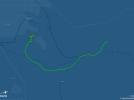Air France A332 over Tanzania on Feb 12th 2012, severe turbulence and temporary loss of control
An Air France Airbus A330-200, registration F-GZCG performing flight AF-3575 from Antananarivo (Madagascar) to Paris Charles de Gaulle (France), was enroute at FL360 over Tanzania, the crew rejected clearances by air traffic control to climb to FL380 twice in order to maintain sufficient safety margins while flying through the Intertropical Convergence Zone (ITCZ). The autopilot and autothrust systems as well as flight directors were connected, the autopilot was in LNAV and ALT mode, the autothrust in SPEED mode maintaining 0.81 mach. There were no returns on the weather radar with various tilt angles and ranges varied between 40 and 160nm, when the crew noticed that the speed began to increase. Shortly after a flash and a cloud was spotted at the right hand side. The speed reached 0.83 mach, the crew reduced the commanded speed without success, then extended the speedbrakes for about 15 seconds which reduced the speed to 0.79 mach, after the speedbrakes were retracted the speed quickly returned to 0.82 mach. Another flash ahead of the aircraft occurred and the aircraft encountered severe turbulence, the pilot monitoring activated the fasten seat belt signs.
During the turbulence the pitch angle continued to increase until the autopilot disconnected, the pilot flying provided nose down inputs, the pitch continued to increase however. The autothrust system disconnected automatically.
The pilot flying was finally able to arrest the climb at FL380 and after 10 seconds at that peak level began to descend the aircraft back to assigned FL360. The pilot flying re-engaged the autoflight systems. The remainder of the flight to Paris went without further incident and was completed with a safe landing. A flight attendant and a passenger were treated for minor injuries received in the turbulence encounter.
The French BEA released their final report concluding the probable causes of the serious incident were:
The incident was due to the non-detection of a convective zone during the rapid development of a cumulonimbus cloud in a tropical zone. This zone was all the more difficult to detect because of the extremely rapid development of the cell.
The lack of any onboard means or tools available to the CCO, which would allow more reliable and effective detection of cells that are forming, contributed to the incident.
Inappropriate adjustment of the range on the ND meant that the crew did not have optimal detection conditions. Taking into account the extremely rapid development of the storm cell, it is not certain whether such detection may have been possible without active monitoring of the onboard weather radar when approaching the turbulent area.
The crew’s appropriate inputs on the flight controls helped maintain control of the aeroplane in flight conditions that had suddenly become very difficult.
The BEA hinted under the title "Strong turbulence in cruise, momentary loss of control of the flight path by the crew", that the captain was pilot flying and the first officer pilot monitoring. About 35 minutes into the flight the crew received a description of satellite images taken about one hour earlier via their ACARS indicating, that the aircraft would encounter a strong convective zone at S12.5 degrees but then experience a smooth area until about S2.5.
Over Tanzania air traffic control cleared the aircraft twice to climb to FL380, in consideration of the weather forecast ahead the crew decided to maintain FL360 and rejected the climb clearance in order to maintain sufficient safety margins for the flight through the zone of possible turbulence.
During the turbulence encounter the flight data recorder recorded:
- pitch attitudes between -6 and +11 degrees
- mach varying between 0.77 and 0.83
- angle of attack varying between -0.7 and +10.2 degrees
- roll angles between -16 and +31 degrees
- vertical speed reaching a maximum of +8500 feet per minute
- vertical accelerations between +0.02 and +2.28G
- lateral accelerations between -0.16 and +0.16G
- flight director bars were removed several times and re-appeared
- the pilot flying applied mainly nose down inputs, especially during the first 10 seconds after the autopilot disconnected
The BEA further reported that the autopilot disconnected because of the high angle of attack. While in manual control the high angle of attack protection activated three times for a total of 8 seconds. During the turbulence encounter the autopilot was re-engaged for about two seconds then disengaged again due to the rejections of the inertial reference units by FMGEC1 due to at least one of the units providing invalid data. The autothrust disconnected when both FMGECs rejected the inertial reference units.
The BEA summarized the crew testimonies:
The Captain said he was surprised by the strong turbulence, which made all flight instruments unreadable, as well as by the intensity of the noise in the cockpit, which resulted in a failure to communicate between the crew. He reported a startle effect followed by a "state of shock".
In addition, he mentioned the sensory illusions which, according to him, made the co-pilot think that the aeroplane was descending while he thought it was climbing.
The co-pilot said he was surprised by the suddenness of the phenomenon. He emphasized the strength of turbulence, which made it impossible to perform routine tasks, and stressed the high level of the aerodynamic noise. He reported focusing on a few parameters (power, attitude and airspeed).
The co-pilot said he was surprised not to have noticed a level bust of more than 2,000 ft because he thought the Captain had managed to maintain the pitch attitude.
The BEA reported that Airbus analysed the aircraft remained within its flight envelope throughout the entire occurrence.
With respect to the weather the BEA reported that it was pitch dark with no moon. Weather information initially received by the crew indicated the possibility of isolated cumulonimbus in the area of where the turbulence event occurred.
The BEA characterized the phenomen of cumulonimbus cloud:
The vertical development of a cumulonimbus is generally limited by the tropopause, whose altitude is between the FL500 and FL600 in the inter-tropical convergence zone. When the top of a cumulonimbus in its maturity phase reaches the altitude of the tropopause, the upper part of the cloud extends horizontally to form "anvils".
The air that feeds a cumulonimbus spreads and cools when climbing. When the top approaches the tropopause, it becomes colder than its environment, which stops its vertical development. Through inertia, the most powerful clouds penetrate beyond the tropopause and their tops are then much colder than their environment: this "overshoot" phenomenon is visible on infrared images, and it makes it possible to characterise the most powerful clouds.
The strongest vertical movements are observed in the "tower" of the cumulonimbus in its phase of rapid growth, i.e. before the top reaches the tropopause and the anvil is formed. Upward speeds can then reach 110 km/h and downward speeds 50 km/h. The vertical speed can thus vary very rapidly inside the cumulonimbus while crossing its cloud tower.
Electrical activity can be strong, with the possibility of the appearance of lightning in the phases of growth or maturity of a cumulonimbus, at any altitude. Lightning can appear between the cloud and the ground, within a cloud or between two clouds.
The BEA analysed the infrared images available: "On the image corresponding to the situation at 00 h 36, there is cloud cover whose top is located around FL280/300 (dark green). The cell was probably building up, but still undetectable by radar at that time. On the image corresponding to the situation at 00 h 36, cloud tops can be observed between FL360 and FL450 (pink dots). For this reason, the relatively small convective cell is not visible on the image at 00 h 45 but is easily detectable on the image at 01 h 00. It is therefore a case of particularly rapid development of an isolated thunderstorm cell. The development of this cell into a large convective cluster within a few hours may suggest the presence of strong updraughts and severe turbulence. In addition, this rapid growth could explain the violent phenomena encountered, related to the dynamism and not to the size of the cell."
With respect to the operation of the weather radar the BEA analysed:
- fifteen minutes before the turbulence, the aeroplane was approximately 120 NM from the centre of the cell. The latter, probably building up, was not detectable by the radar;
- ten minutes before the turbulence, the aeroplane was approximately 80 NM from the centre of the cell. Adjusting the range to 80 NM with a corresponding adjustment of the tilt may have allowed the crew to detect the developing convective cell;
- five minutes before the turbulence, the aeroplane was approximately 40 NM from the centre of the cell. Adjusting the range to 80 NM with a corresponding adjustment of the tilt would probably not have allowed the crew to detect the developing convective cell. Adjusting the range to 40 NM would probably have allowed the crew to detect the cell at that time.
Introducing two safety recommendations to introduce more advanced already existing radar technology to assist in detection of developing convective cells as result of the investigation the BEA stated: "This incident showed that the installation of a technologically more advanced type of radar would probably have helped the crew detect the convective cell without, however, neglecting the need for active monitoring of the meteorological situation."
Analysis of infrared images at 00:36Z (Graphics: BEA):
Analysis of infrared images at 00:51Z (Graphics: BEA):
http://avherald.com/h?article=477d6182














Komentarze